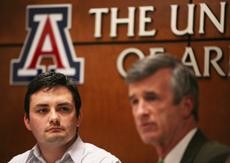A proposal that would add a $1,000 “”economic recovery surcharge”” to students’ tuition was considered at Thursday’s meeting of the Arizona Board of Regent’s Tuition Task Force.
The fee, which UA President Robert Shelton proposed to the board, is being looked at as a more effective way, than relying on federal stimulus money, to replace the $77 million permanent cut to the university’s state appropriations.
While the UA still plans to receive part of the $832 million, which is dedicated toward the state of Arizona’s education system, these funds are being viewed as a short-term fix that will not help to balance the budget in coming years.
The amount of stimulus money, intended for university education, could be anywhere between $225 million and $300 million, said Richard Stanley, senior vice president and university planner for Arizona State University.
If the university were to receive no stimulus funding, Shelton said, the surcharge would have had to be closer to $2,000.
“”We understand that that is completely unrealistic. It is not a burden that we feel even with financial aid, can be placed on the backs of our students and their families,”” Shelton told the task force. “”Fortunately we can anticipate ð- we don’t know the number – we can anticipate some help from the federal (American Reinvestment and Recovery Act).””
If approved by the regents, at their April 30 meeting, the tuition surcharge would generate $20 million in revenue after 20 percent of the funds were set aside for financial aid at both the graduate and undergraduate level, Shelton said.
The money generated would be the equivalent to what the state provides to fund two colleges, 100,000 student credit hours, 4,000 full time students, 1,000 degrees and more than 500 employees, he said.
The amount of stimulus funding the universities will receive depends on the how much the state cuts in the first place, Stanley said.
“”It is a good news, bad news situation,”” he said. “”If we get more money that means we were cut more.””
Shelton also said, in the memo, that it would not be out of the question to assume that there could be another 10 percent cut to the university’s state funding in fiscal year 2010, which begins July 1.
UA Student Regent David Martinez III said student advocates plan to work with the board to establish tuition at a reasonable level that maintains the quality of the three institutions.
“”We are more than willing – student advocates are – to work in the spirit of shared governance with the university administration and regents to ensure that we, as a team, can weather this storm together so that when we do come out of this storm our universities maintain the quality and the excellence that students deserve,”” he said.
Shelton said he has recommended a tuition surcharge, instead of a fee, in order to allow students who receive tuition scholarships, to maintain their funding levels. The health affairs schools will incur the only additional fees.
“”What we are looking at, is trying to find necessary dollars to enhance our ability to serve these students in these difficult times and those dollars would be applied, whether they’re called tuition or fees, to maintaining those services that students feel are most important,”” he said.
ASU Student Regent Ross Meyer said, while the surcharges continue to be necessary, it is important for the board to reconsider them, every year, at their annual December tuition-setting meeting.
Martinez closed by saying that the board and the universities must be cautious when it comes to raising tuition in response to budget cuts because it gives the state legislature a direct influence on the tuition level.
“”I am really afraid of the road we’re going down, in essentially matching state cuts to tuition and fee surcharges or increases, and a sort of precedence it is setting and I feel like this is exactly what legislature leadership want, he said.””
Shelton said the $1,000 is an estimate, for now, but the three university presidents will release their final tuition plans today.









